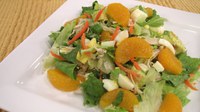Prairie Fare: Take Care of Your Eyes
(Click an image below to view a high-resolution image that can be downloaded)
By Julie Garden-Robinson, Food and Nutrition Specialist
NDSU Extension Service
“Mom, I’ll help you,” my 11-year-old daughter said. I think I detected a smirk on her face.
“No, I can do it,” I replied with a bit of determination in my voice.
“No, really, I can do it for you,” my daughter persisted. She definitely had a smirk on her face this time.
I squinted, squeezed my eyes together and did a “super blink.” That didn’t help.
After a few more attempts and verbal exchanges with my daughter, I finally gave up and handed her the fine needle and piece of thread.
I have been teaching her how to sew, and we were working on sewing invisible hems, which requires a small needle with a nearly invisible eye, at least in my estimation.
I was wondering whether that needle had an eye at all.
My daughter had a little trouble threading the needle, too, so I had the opportunity to grin at her. Then she handed the threaded needle to me triumphantly, and I showed her how to stitch an invisible hem.
I put my pride aside and pulled out my free-standing magnifying glass for the next needle-threading attempt. Fortunately, I haven’t reached the stage where I need super-long arms to read the newspaper, but reading glasses may be in my future.
Fortunately, many vision issues can be corrected. “Low vision” is the term given to vision that cannot be corrected with glasses, contact lenses or surgery. According to the National Eye Institute (NEI), 135 million people around the world have low vision, and the number is expected to grow as the population ages.
Low vision can interfere with our ability to drive, read, detect color, see the TV, adjust to glare, see in dark areas and even recognize faces.
The main causes of low vision include macular degeneration, cataracts, glaucoma and diabetic retinopathy. Uncontrolled diabetes, smoking, poor diet and aging are among the risk factors for low vision, and we can do something about most of these factors except, unfortunately, aging.
According to the NEI, about 45 percent of low-vision cases result from age-related macular degeneration.
Macular degeneration is one of the leading causes of blindness, and scientists have found that diet can play a role in preventing this eye disease. The macula is a region close to the optic nerve at the back of our eyes that allows us to see clearly and distinguish colors. It is composed of lutein and zeaxanthin, which are pigments also found in colorful fruits and vegetables.
Some good sources of zeaxanthin are kale, collard and spinach greens, orange bell peppers and corn. Some good sources of lutein are kale, green leafy vegetables, spinach, corn, peas, and yellow and orange vegetables. Egg yolks are another excellent source of lutein.
Having difficulty seeing can make shopping for food and cooking more challenging but not impossible. Fortunately, adaptive tools such as “talking” kitchen scales, thermometers and microwave ovens are available. You can purchase measuring cups with bold print, vegetable peelers held in the palm of the hand, and brightly colored cutting boards that contrast with your countertop.
If you or perhaps an aging family member have difficulty seeing to cook, try to limit glare in the kitchen. Shiny appliances are trendy but increase the glare. Adding gooseneck lamps to provide more light and blinds over the windows can help.
Taking care of our eyes is important all of our life, and nutrition can play a role in maintaining our precious vision. Consider your eyes when you peruse a farmers market, make your grocery list or choose foods at a restaurant. Be sure to see your eye-care professional annually for a vision screening.
For more information and a variety of vision-related resources, visit http://www.ndsu.edu/boomers and click on “Eyes,” then “5 Things to Do to Nourish Your Eyes.”
Here’s a delicious eye-healthy recipe that you can serve with your favorite dressing or the recipe provided.
Asian Style Cobb Salad
5 c. chopped romaine lettuce (or spinach)
1 (11-ounce) can mandarin oranges in light syrup or juice, drained
1/3 c. cooked chicken, shredded
1/3 c. grated carrots
1 avocado, halved, seeded, peeled and diced
2 hard-cooked eggs, diced
1/4 c. green onions, sliced
Sesame Vinaigrette Dressing
1/4 c. plus 2 Tbsp. rice wine vinegar
1 clove garlic
1 Tbsp. sesame oil
1 Tbsp. sugar
1 tsp. ground ginger
1 tsp. soy sauce
- Broil, bake or grill chicken.
- Cook eggs. Place eggs in a small saucepan with cold water. Heat water just until boiling. Remove from heat and cover; let stand for 12 minutes. Drain water and eggs into a colander. Rinse eggs with cold water to stop cooking. Use immediately.
- Prepare the dressing by whisking together all ingredients in a small bowl; set aside.
- Assemble salad by placing greens in a large bowl; top with mandarin oranges, chicken, carrots, avocado, eggs and green onion.
- Serve immediately.
Makes four servings. Each serving has 250 calories, 14 grams (g) fat, 8 g protein, 26 g carbohydrate, 5 g fiber and 160 milligrams sodium.
(Julie Garden-Robinson, Ph.D., R.D., L.R.D., is a North Dakota State University Extension Service food and nutrition specialist and professor in the Department of Health, Nutrition and Exercise Sciences.)
NDSU Agriculture Communication - June 18, 2015
| Source: | Julie Garden-Robinson, (701) 231-7187, julie.garden-robinson@ndsu.edu |
|---|---|
| Editor: | Ellen Crawford, (70) 231-5391, ellen.crawford@ndsu.edu |



